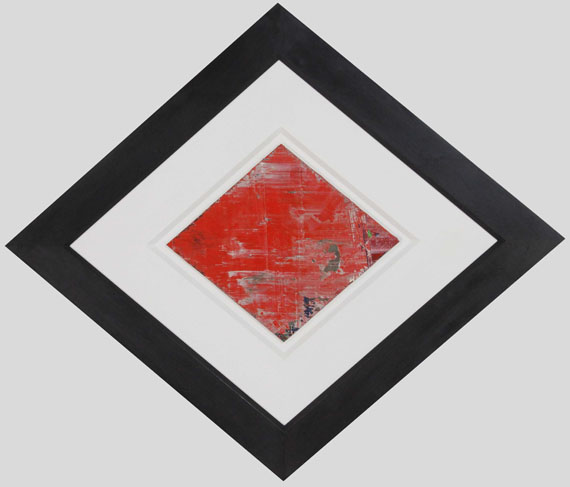805
Gerhard Richter
Rhombus, 1998.
Oil on panel
Estimation:
€ 250,000 / $ 267,500 Résultat:
€ 325,000 / $ 347,750 ( frais d'adjudication compris)
Rhombus. 1998.
Oil on panel.
Elger 850-13. Verso signed and dated as well as inscribed with the work number by a hand other than that of the artist, however, on behalf of the artist. 24 x 28 cm (9.4 x 11 in).
This is the only work available on the international art market, that was made in context of the acclaimed 'Rhombus-Zyklus'. The complete series is on display at the Museum of Fine Arts, Houston, Texas.
With a written expertise issued by Dr. Dietmar Elger, Dresden, on July 4, 2018.
PROVENANCE: Private collection Southern Germany (acquired directly from the artist).
"The oil sketch "Ölskizze, Rhombus (850-13)" by Gerhard Richter is a true gem. The picture was made in direct connection with the six-part cycle "Abstraktes Bild, Rhombus (851/1-6)" that Richter had originally created for the church Padre Pio in San Giovanni Rotondo in Italy. It is the only work in extistence that anticipates the rhomb-shaped works."
Dietmar Elger, director of Gerhard Richter Archive, Dresden
"Abstract painting offered us a better way to approach the intangible and unintelligible, as its direct appearance, meaning its means of art, are not about illustration or depiction".
Gerhard Richter, 1982, quote from: Cat. Documenta 7, Kassel 1982.
Oil on panel.
Elger 850-13. Verso signed and dated as well as inscribed with the work number by a hand other than that of the artist, however, on behalf of the artist. 24 x 28 cm (9.4 x 11 in).
This is the only work available on the international art market, that was made in context of the acclaimed 'Rhombus-Zyklus'. The complete series is on display at the Museum of Fine Arts, Houston, Texas.
With a written expertise issued by Dr. Dietmar Elger, Dresden, on July 4, 2018.
PROVENANCE: Private collection Southern Germany (acquired directly from the artist).
"The oil sketch "Ölskizze, Rhombus (850-13)" by Gerhard Richter is a true gem. The picture was made in direct connection with the six-part cycle "Abstraktes Bild, Rhombus (851/1-6)" that Richter had originally created for the church Padre Pio in San Giovanni Rotondo in Italy. It is the only work in extistence that anticipates the rhomb-shaped works."
Dietmar Elger, director of Gerhard Richter Archive, Dresden
"Abstract painting offered us a better way to approach the intangible and unintelligible, as its direct appearance, meaning its means of art, are not about illustration or depiction".
Gerhard Richter, 1982, quote from: Cat. Documenta 7, Kassel 1982.
The pilgrimage church San Pio da Pietrelcina in San Giovanni Rotondo was built between 1991 and 2004 after the design of the star architect Renzo Piano. In 1997 Gerhard Richter was invited to depict life and stigma of St. Francis for this church. Richter, self-confessed sympathizer of the Catholic Church, was interested in the project, however, he was not capable of executing a figurative representation of the theme, so he delivered a work group of six abstract rhomb-shaped paintings. Our small-size work was created in context of the making of the large rhombs. The works were rejected by the committee that was in charge of the church's decoration. In 2001 they were shown at the Biennial as part of the theme exhibition "Plateau der Menschheit" (Plateau of Mankind) and eventually acquired by the Museum of Fine Arts in Houston/Texas. The mystical sacral aura that these works emanate is a remains of their history of origin. The dominant blood-red, ruptured by streaks of gray and royal blue, even a tiny spot of emerald green is visible. The intangible, mystically veiled that surrounds all divine is an attribute that also applies to Gerhard Richter's abstract painting. He realizes this effect by means of the squeegee, a technique he conceived in the mid 1980s. This tool allows him to integrate the aspect of coincidence as a means of creation, leaving him control only over his choice of color, format, material and the squeegee's direction of execution, while he has no influence on how much paint will stick to a specific part of the canvas. The painting process is characterized by coincidence and destruction, because once Richter puts the squeegee at a different spot on the canvas he destroys the previous composition. The origination process is determined by an up and down, by intuitively made decisions. "Making pictures is characterized by many Yes or No decisions and one Yes decision at the very end of it." (Gerhard Richter, quote from: Dietmar Elger, Gerhard Richter. Maler, 2018, p. 349) [SM]
805
Gerhard Richter
Rhombus, 1998.
Oil on panel
Estimation:
€ 250,000 / $ 267,500 Résultat:
€ 325,000 / $ 347,750 ( frais d'adjudication compris)




 Lot 805
Lot 805 
